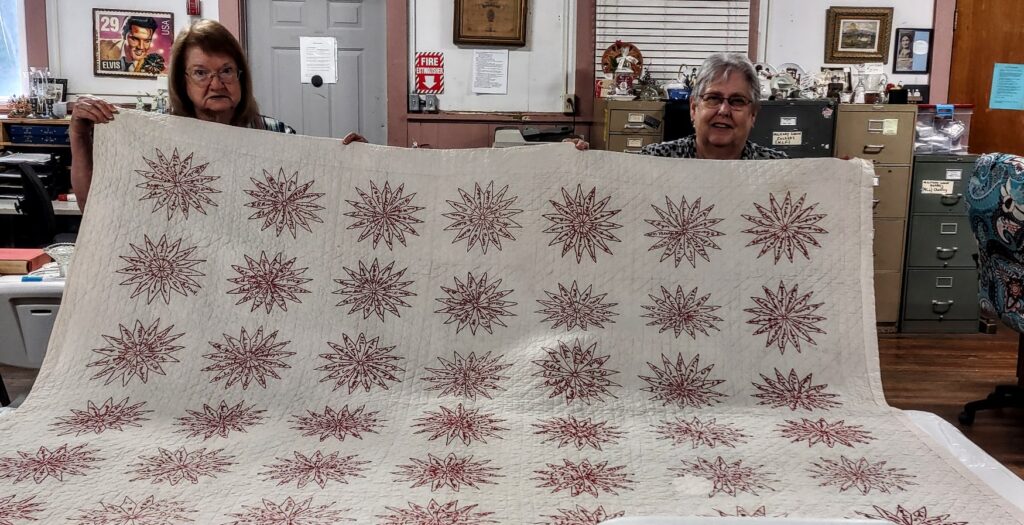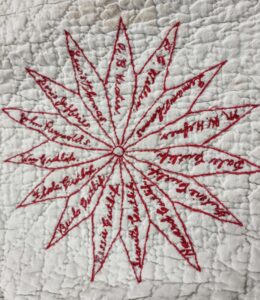

Enjoy the story about this beautiful signature quilt, and click on the links at the bottom to see a list of the names that are included on it. There is an alphabetical list and a list arranged by county.
THE QUILT MYSTERY
By Mary S. Glass
It was in a large house in Webster Springs that I found one of a number of quilts, but this one was different. Like others, the quilting was done by hand with very tiny stitches. The quilt was made of unbleached muslin and cotton batting. Large flowers were embroidered on the muslin, each with fifteen petals, and each petal bearing the name of a person. There were seven rows of flowers, and each row contained six flowers. Do the math. That means that this quilt contained 630 names embroidered upon it, plus an extra name near one of the flowers.
Just who were these people, and just who made this quilt? How old is this quilt? It is in remarkable shape, with the exception of a hole cut into one of the flowers. Was something spilled on that spot that ate into it, requiring the spot removed physically? Was there a small burn that required the area to be surgically removed? Or did the maker of the quilt have a falling out with the individual embroidered at that spot and decided to physically remove that person from her life and from the quilt? (By the way, the hole has been recently repaired.)
Just who might have been the person who did all this work? The house was built about 1907 for a recently married couple by the groom’s father. They moved into the house where they raised five children. The wife who was so fortunate to live in such a fine house was my grandmother, Mary Rutherford Skidmore. She had grown up in Center District of Gilmer County, the daughter of Minter n and Sarah Brannon. She had an eighth-grade education and lived on a farm with a love of riding horses. Her parents had a large family and were not well off financially. She had gone to Webster Springs to help in the Rutherford Hotel run by her aunt and uncle, Alice and Archie Rutherford, where she met John B. Skidmore, a banker in the town. She was an excellent seamstress, as evidenced by her very tiny stitches.
But she wasn’t the only woman who spent part of her life 3 Sep1974 in that house. Her mother-in-law, Nancy Raikes Skidmore, lived in the house when her husband was dying and later as a widow until her death. Although she was born in Buckingham County, Virginia, she grew up in the southern part of Upshur County where she served as a school teacher before her marriage to Levi Skidmore. She was skilled in homemaking activities, cooking for inmates in the jail where her husband was sheriff and teaching her granddaughter how to make biscuits and other food. She quilted on an old quilting frame, made linsy-woolsey on a loom with delicate designs, and did beautiful embroidery.
Another candidate is the mother-in-law of Vivian Skidmore Griggs who spent her last years as an invalid in that house, bringing with her the items she had made over her lifetime. May Beall had grown up in Ritchie County and married Claude Griggs. They settled first in Vadis in Lewis County and then moved to Weston. She was also a quilt maker and did other handicraft work.
I suppose that there were others who may have been in the house temporarily among my grandmother’s sisters who had lived in various places. Nevertheless, in searching for clues as to who made the quilt and when, it became apparent that we needed to find out more about the people whose names are on the quilt and try to look for a relationship between them. More questions arose. Just what was the connection between those 630 people? Were they related? Did they belong to the same church or social organization? Were they neighbors?
But, before exploring the names on this quilt, perhaps we should learn a little about the history of signature quilts in the United States to give us some ideas about this one. Signature quilts have been a part of needlework heritage since the 1600s. Typically, they were made to commemorate special events in a family or community or support causes such as a war effort, temperance, a church, or a school. They could be used as fund raisers. For instance, women might sell a place on their quilts for something like ten cents. Even more money would be raised if the quilt was raffled off. These quilts rose to prominence in the 1830s and 1840s. (Edwards)
Jody Sanders wrote that signature quilts could be generally classified into four categories:
- Album Quilts – These were keepsake quilts that might be made as a wedding gift. Inside of blocks would be a place for a name to be written or embroidered.
- Presentation Quilts – These were made to honor the recipient for a special event, retirement or even as a parting gift when someone was moving away.
- Fundraising Quilts – Quilts made specifically to raise money for an organization, charity, missionary work, a political point of view, or a church. An individual or family name would be added to the quilt for a small contribution. Sanders reported that these quilts can be easily recognized due to the large number of names on the quilt.
- Celebrity Quilts – These quilts were made from blocks of fabric that had been sent to celebrities, politicians, or prominent members of a community with a request that they be signed and mailed back. The blocks were then returned with a signed photograph or letter by the person to help authenticate the signature. These blocks were then sewn into a quilt. (Sanders)
Based on the above and the fact that there are 631 names or initials representing names, one might assume that the mystery quilt was likely made as a fundraiser. This still does not tell us about how the quilt was obtained, who made it, nor much about the people whose names appeared on the quilt. It also does not indicate the cause for which it was made.
To explore this, we need to find out who these people were and locate them, when possible, on United States census records. This would give a clue regarding where they lived and when, and possibly when the quilt was made. Some names were very difficult to read with the embroidery. Some did not have last names, but most of those appeared to be children of the person preceding them. Some of the wives did not have given names on the quilt, but were listed as Mrs. beside the name or initials of their husbands.to be
Nevertheless, the task was apparent. Each name on the quilt needed to be copied. Indexing census records was a piece of cake compared to deciphering many of the names embroidered on the quilt, some squeezed into the size of the petal of a flower. Nevertheless, most were legible enough to identify. Then came taking each name and trying to find it in census records. In doing so, it was found that the majority of people identified lived in Braxton County, West Virginia, or neighboring counties. The vast majority of these lived in the Salt Lick District of Braxton County in 1920 – a few being found only in the 1910 census, and some only in the 1930 census. The youngest child found on the quilt was born about 1925. Based on this, it appears that the quilt was likely completed around 1925. (However, there were three people by the name of Benjamin F Conrad – one deceased, one living in Glenville at the age of 77 in 1920, and one age 0 in 1930 in Braxton County. No other Conrads were found on the quilt. Thus it appears that it is unlikely to be the baby born around 1930.) The 42 quilt squares may have been embroidered by one or several persons.
Many of the people who were not living in the areas mentioned either grew up there, had relatives living there, or worked in occupations where they were mobile – coal miners, lumbermen, clergymen, traveling salesmen, and so on. Several people were listed on the quilt as duplicates. Perhaps they donated more than once to the cause. Some were teenagers without their parents named, and some were under the age of five.
Several names were names of people who were deceased. Each flower contained fifteen names. One particular flower appeared to contain the names of the people in the family of William Andrew and Edna Knight living in Salt Lick District. In searching census records, four names did not show up. Searching for these names in the Braxton County birth records, it was found that one had been stillborn, and three were triplets. In searching death records, it was found that two of the triplets had died the day they were born, and the other had died the following day. This family wanted to memorialize all their children on that quilt – those living and those they had lost in infancy.
It is obvious by the large number of names on the quilt that a large number of people supported this venture, and this support went further than just Braxton County. There were families with the surnames of Beall and Griggs on the quilt, but these did not appear to link to the family members of May Beall Griggs. There were Hyers on the quilt, but not descendants of Mary Raikes Hyer, wife of Edwin Hyre and sister of my great-grandmother, Nancy Raikes. However, it brings to mind the daughter of another sister in that family, Susan Raikes Mace. The children in the Raikes family grew up in Holly Grove, Banks District of Upshur County, just north of Salt Lick District in Braxton County. When Susan married Eli Mace, they settled in Hacker Valley of Webster County. Their daughter, Rose A. Mace, was born in 1879, became a college graduate of West Virginia Wesleyan College, and served as a missionary in China for the Methodist Episcopal Church for most of her life. Periodically, she would return to the United States and speak to various groups about the work she was doing in China and inviting people to donate to the cause. She was my grandfather’s cousin, and my grandmother, a Baptist in Webster Springs, wrote to her regularly and encouraged her fellow church members to contribute financially to the work that Rosa was doing for the people in China. Although none of the names of my family appear on the quilt, it is not unthinkable to imagine my grandmother, who had enough means to do so, bidding on this quilt as a support for this cousin’s work, if indeed this was why the quilt was made.
We may never know exactly why the quilt was created, nor how it came into the possession of this particular family, but we do know it is a little piece of the history of this region in West Virginia. The time has come to revive this quilt as a fundraiser for a worthy cause, this being the Hacker’s Creek Pioneer Descendants Association. If you wish to know whether your family is represented on this quilt, consult the spreadsheet found at the Hacker’s Creek website.
Sources:
Edwards, Karen. “All About Signature Quilts,” Family Tree Magazine. .
Sanders, Jody. “History of Signature Quilts,” American Patchwork and Quilting.